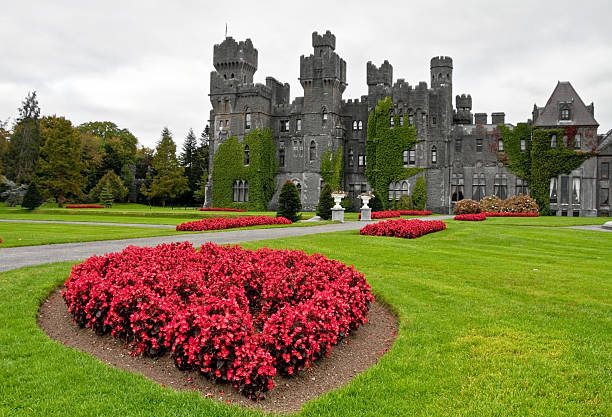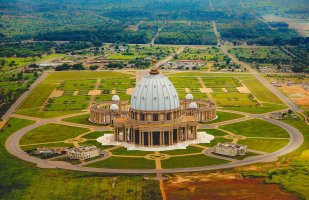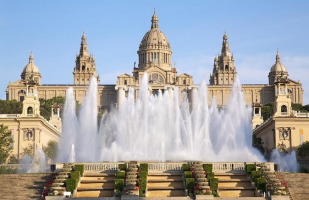Top 10 Most Amazing Monuments in Europe
Many travelers from all around the world are drawn to European architecture. If you are an enthusiastic historian or simply enjoy excellent architecture, you ... read more...should plan a trip to Europe to see all of the wonderful landmarks on show. European monuments are unlike anything else in the world, and it's no wonder that nations all over the world are adopting or recreating these architectural forms. Let's take a look at the most impressive monuments in Europe now.
-
The Atomium is a popular tourist destination across the world. This one-of-a-kind architectural sculpture, built for the 1958 World Fair in Brussels, quickly became Europe's most popular monument. The Atomium was designed by engineer André Waterkeyn for the 1958 World Fair in Brussels. Its initial structure is an iron crystal magnified 165 billion times. Today, the Atomium's five circles are available to the public. The primary sphere has a permanent display that explains the origins of the Atomium and the 1958 World Fair. Temporary displays are accepted in another sphere. Finally, the tallest sphere houses a café with a fantastic view over Brussels.
The Atomium is one of Belgium's highest structures, at 102 meters tall. Its nine 18-meter-diameter stainless steel-clad spheres are linked in the configuration of a unit cell, which might represent an iron crystal multiplied 165 billion times. Steel tubes that link the spheres encompass stairs, escalators, and an elevator (in the central, vertical tube) that provide access to the six visitable spheres, which house exhibit halls and other public areas. The top sphere houses a restaurant with a 360-degree panorama of Brussels. With over 600,000 visitors every year, the Atomium is today the most popular tourist attraction in Europe's capital, an art center, and a worldwide emblem of Brussels and Belgium. It is a cultural location as well as a heritage site. Over half of the facility is dedicated to exhibits with Belgian and digital arts topics.
Location: Brussels, Belgium

istockphoto 
istockphoto -
Hallgrímskirkja is a major landmark in Reykjavik. The majestic church dominates the metropolitan skyline, soaring like a concrete geyser from the capital's heart. However, while it is now a well-loved structure, the church was once a contentious topic. It has been considered as a vital emblem for Iceland's national identity since its completion in 1986, owing to its characteristically curving spire and side wings. The church is named after the composer of the Passion Hymns, Icelandic poet and priest Hallgrmur Pétursson.
While the work of architect Gujón Samelsson was heavily influenced by Scandinavian Modernism, often known as Functionalism, he also sought inspiration from nature itself. Gujón built the Lutheran church to reflect Iceland's trap rock formations, mountains, and glaciers. This is particularly visible in the church's wings and steeple, which were inspired by the spectacular basalt column cliffs seen along Iceland's south coast.
The church's front courtyard has an amazing monument of Norse adventurer Leifur Eirksson (Leif Erikson), the first European to settle in North America, 500 years before Christopher Columbus. The statue of Leifur predates the church by a long time. The piece of art was given to the people of Iceland by the United States in 1930 to commemorate the thousand-year history of the Icelandic parliament, which was founded in 930 ADS at ingvellir.
Location: Reykjavik, Iceland

istockphoto 
istockphoto -
Ashford Castle offers unrivaled service, genuine Irish friendliness, and five-star grandeur. Discover luxurious apartments and suites, superb interiors packed with antique furniture, fine textiles, and distinctive features at every turn in a spectacular 350-acre estate on the shores of Lough Corrib. The 83 rooms, suites, and Hideaway Cottage are all designed with classic elegance and grace. The apartments and suites have been meticulously constructed to blend the castle's historical characteristics with the most up-to-date modern conveniences. Unique pieces of art meticulously acquired antique furniture, and rich textiles with custom-designed rugs, handcrafted beds, feature lighting, fine towelling, and Egyptian cotton bed linen demonstrate meticulous attention to detail.
Every magnificent suite is infused with creativity, with rich and complex decor inspired by the unique, historical surroundings. Rare, hand-selected antiques accent the silk-lined walls, handpicked artworks, and silk drapes that frame views of the lush gardens and the lake beyond. Discover innovative Irish cuisine inspired by the best seasonal ingredients from the West of Ireland and products foraged from the Ashford Estate, as well as a vast wine cellar hidden away in the castle's secret corridors. Fine dining in the opulence of the George V Eating Room, relaxed dining in the gorgeous setting of Cullen's at the Cottage, or a wonderful afternoon tea in the magnificent Connaught Room will not disappoint.
Location: Ireland

istockphoto 
istockphoto -
The Pena Palace is a Romanticist palace located in So Pedro de Penaferrim, Sintra, on the Portuguese Riviera. The castle is located on a hill in the Sintra Mountains above the town of Sintra and can be seen from Lisbon and much of its metropolitan area on a clear day. It is a national monument and one of the world's major manifestations of 19th-century Romanticism. The palace is a UNESCO World Heritage Site and one of Portugal's Seven Wonders. It is also used by the President of the Portuguese Republic and other government officials for state events.
After Ferdinand's death, the palace passed to his second wife, Elisa Hensler, Countess of Edla. The latter later sold the palace to King Lus, who wanted it back for the royal family, and the palace was regularly utilized by the family after that. It was bought by the Portuguese state in 1889, and following the Republican Revolution of 1910, it was designated as a national monument and converted into a museum. Queen Amélia, Portugal's last queen, spent her final night at the palace before fleeing the nation in exile.
The palace immediately drew visitors and became one of the most visited landmarks in Portugal. The hues of the red and yellow façades faded with time, and the palace was visually characterized as being wholly gray for many years. By the end of the twentieth century, the palace had been repainted and the original colors had been restored. UNESCO designated the palace and the rest of Sintra's Cultural Landscape as World Heritage Sites in 1995.
The Pena Palace is decorated in a variety of styles that reflect the exotic taste of Romanticism. The diverse blend of styles includes Neo-Gothic, Neo-Manueline, Neo-Islamic, and Neo-Renaissance. Much of this has been visible since significant restorations in the 1840s. There are also references to other notable Portuguese structures, such as the Belém Tower.
Location: Sintra, Portugal

istockphoto 
istockphoto -
The Tower of Pisa is one of medieval Europe's most spectacular architectural marvels. It is located in Pisa, Italy, one of the most visited cities in Europe. The Tower of Pisa is more correctly known as the Campanile, or bell tower. The Pisa Tower is one of four buildings that comprise the Campo dei Miracoli or Piazza dei Miracoli, which meaning Field of Miracles, in Pisa, Italy. The cathedral, or Duomo di Pisa, was the first structure built at Campo dei Miracoli in Pisa, and it stands on a white marble pavement and is an exceptional example of Romanesque architecture.
The baptistery, located about west of the dome, was the third structure to be erected. The construction of the campanile then commenced. The cemetery, Campo Santo, was erected before the campanile was finished. Pisa's Piazza dei Miracoli is Italy's most magnificent assembly of Romanesque buildings. The cathedral, with its oddly Islamic dome and matching domed baptistery, rises from an emerald, green lawn and is faced in gray-and-white striped marble and bristling with columns and arches. The camposanto, or cemetery, flanks one side of the plaza, containing a burial place with dirt supposedly carried back during the Crusades from Golgotha, the hill where Jesus was crucified, so that aristocratic Pisans might rest in consecrated ground.
The piazza's crowning attraction is the Leaning Tower of Pisa. Although barely one-third the height of the Washington Monument, it was a marvel of medieval architecture and one of Europe's highest bell towers. Tower of Pisa appears like a big wedding cake pushed perilously awry by a clumsy large guest, with 207 columns ranging approximately eight floors. The building of the Tower of Pisa began in August 1173 and lasted around 200 years due to the outbreak of a succession of wars. The architect's identity remains unknown to this day. The Cathedral and the Leaning Tower of Pisa the Leaning Tower of Pisa was intended to be a 185-foot-high circular bell tower. It is built of white marble.
Location: Pisa, Italy

istockphoto 
istockphoto -
Welcome to an expensive and spectacular pleasure palace. The Royal Pavilion, built in stages between 1787 and 1823 for the prince Regent, afterwards King George IV, is notable for its exotic oriental aspect both inside and out. This beautiful royal pleasure palace was admired by sophisticated Regency society and remains a distinguishing feature for vibrant Brighton & Hove today. The Royal Pavilion also houses some of Britain's greatest collections and specimens of the chinoiserie style. Brighton & Hove City Council handed over ownership and operation of the Royal Pavilion & Museums' facilities and collections to a new charity, the Royal Pavilion & Museums Trust, on October 1, 2020.
The baptistery, located about west of the dome, was the third structure to be erected. The construction of the campanile then commenced. The cemetery, Campo Santo, was erected before the campanile was finished. Pisa's Piazza dei Miracoli is Italy's most magnificent assembly of Romanesque buildings. The cathedral, with its oddly Islamic dome and matching domed baptistery, rises from an emerald, green lawn and is faced in gray-and-white striped marble and bristling with columns and arches. The camposanto, or cemetery, flanks one side of the plaza, containing a burial place with dirt supposedly carried back during the Crusades from Golgotha, the hill where Jesus was crucified, so that aristocratic Pisans might rest in consecrated ground.
The Royal Pavilion Garden, located in the Pavilion grounds, includes a diverse collection of plants that have been restored to Nash's original Regency vision. It is considered to be the UK's only fully restored Regency Garden. The garden is maintained by the Trust's garden crew, which includes volunteers and is overseen by a Head Gardener. Street entertainers frequently use the garden, especially during the summer. In the garden, there is also a café.
Location: Brighton, UK

istockphoto 
istockphoto -
Guggenheim Museum, worldwide museum run by the Solomon R. Guggenheim Foundation that acquires and displays modern and contemporary art in New York City and other locations. The Solomon R. Guggenheim Museum in New York City, the Peggy Guggenheim Collection in Venice, and the Guggenheim Museum Bilbao in Spain are the Guggenheim's component museums.
The museum found a permanent home in an innovative new structure built by Frank Lloyd Wright in 1959. The structure, spiraling upward and outward in elegantly sculptured coils of vast plain white concrete, is a striking departure from standard museum architecture. The interior exhibition area consists of a spiral staircase of six "stories" around an open center space lit by a glass dome supported by stainless steel. Many of the artwork's "float" off the angled outer wall on hidden metal arms. In 1992, the museum was extended with the construction of a neighbouring 10-story tower. Wright's structure became one of his most recognizable designs, and it was named a UNESCO World Heritage site in 2019.
The Guggenheim Museum houses a large collection of European painting from the twentieth century as well as American painting from the second half of the century. The museum has the world's greatest collection of Wassily Kandinsky paintings, as well as pieces by Pablo Picasso, Paul Klee, and Joan Miró, among others. Modern sculpture is highly represented as well.
Location: Bilbao, Spain

istockphoto 
istockphoto -
The Dunmore Pineapple is a folly at Dunmore Park in Stirlingshire, Scotland, near Airth. It was named "as the most bizarre building in Scotland". Dunmore Park, the historic seat of the Earls of Dunmore, has a huge country palace, Dunmore House, and grounds that feature two enormous walled gardens, among other things. In the eighteenth and nineteenth centuries, walled gardens were a must for any great house in a northern climate, as a high stone or brick wall helped to shelter the garden from wind and frost, and could create a microclimate in which the ambient temperature could be raised several degrees above that of the surrounding landscape.
This enabled the growth of fruits and vegetables, as well as decorative plants that would not have survived otherwise so far north. Walled gardens occasionally comprised a single hollow, or double, wall containing furnaces, holes along the side facing the garden to let heat to escape, and chimneys or flues to pull smoke upwards. This was especially beneficial for fruit trees and grape vines, which could be planted even further north than the microclimate generated by a walled garden would ordinarily allow if cultivated within a few feet of a heated, south-facing wall. The Dunmore Pineapple is frequently cited as one of the best follies in the United Kingdom, including on lists compiled by the news aggregator Huffington Post, the environmental television series and magazine Countryfile, and gardener-presenter Alan Titchmarsh.
Location: Airth, Scotland

Fine Art America 
Britain Express -
Many Barcelona locals regard the Temple Expiatori de la Sagrada Famlia (Expiatory Temple of the Holy Family) to be the city's icon, and it is a must-see while visiting the Catalan capital. Originally meant to be a modest Roman Catholic church devoted to Jesus, Mary, and Joseph, the church evolved into the most visible example of Catalan Modernism. In 2010, Pope Benedict XVI designated it as a basilica.
The basilica, designed by Catalan architect Antoni Gaud, embodies Gaud's concept that nature is God's creation. Gaud attempted to merge Christian rhetoric and biblical allegory with sophisticated natural symbolism such as organic, geometric shapes that appear in every column, pinnacle, and stained-glass window of the basilica.
The eventual product is an incredible architectural masterpiece that, despite being unfinished and under development for almost 140 years, has become one of Spain's most visited monuments, with 4.7 million visitors in 2019. The Basilica is made up of five naves shaped like a Latin cross, with angled pillars supporting the roof. These angled pillars are a treelike column construction that mimics a real forest with dappled light coming through.
Each of the three outside faces has four towers that depict the 12 apostles. Gaud designed the Nativity Facade, which was designated a UNESCO World Heritage monument in 2005, together with the crypt. The disputed Passion Facade, designed by Josep Maria Subirachs, is located on the west side and has been highly criticized for being too abstract and not adhering following Gaud's concept. When completed and adorned with its missing four towers, the incomplete Glory Facade is expected to be the most beautiful of the three.
Location: Barcelona

istockphoto 
istockphoto -
The Colosseum, also known as the Flavian Amphitheater, is a vast Roman amphitheater. It was erected as a gift to the Roman people during the reign of the Flavian emperors. Emperor Titus celebrated the opening of the Colosseum with a hundred days of gladiatorial sports. The games were historically visited by Emperors. The emperor Commodus is said to have performed hundreds of times in the arena. The Colosseum also featured plays, reenactments, and even public executions in addition to sports.
The Colosseum hosted gladiatorial fights as well as a variety of other events. The concerts, known as munera, were usually put on by private persons rather than the government. They had a major religious component, but they were also displays of power and family status, and they were hugely popular with the populace. The animal hunt, or venatio, was another popular sort of spectacle.The Colosseum is now a famous tourist destination in Rome, with thousands of visitors visiting each year to see the inside arena. In the upper story of the building's outside wall, there is currently an Eros Museum. A portion of the arena floor has been resurfaced. A network of subterranean corridors underneath the Colosseum that were once used to bring wild animals and gladiators to the arena opened to the public in the summer of 2010. The Colosseum has appeared in numerous films, artworks, and games. It's featured in movies such as Roman Holiday, Gladiator, The Way of the Dragon, The Core and Jumper and games like Assassin's Creed: Brotherhood, Ryse: Son of Rome, and Forge of Empires.
Location: Rome

istockphoto 
istockphoto






























